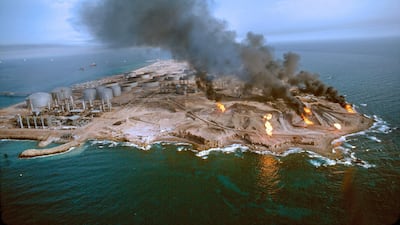In a simple folder lies a couple of yellowing pages. Marked secret and written in 1933, the report describes an uninhabited barren island off the coast of Abu Dhabi. A refuge for seagulls and cormorants, the RAF was considering using Das Island as an emergency landing ground for Imperial Airways flights from London to India.
Britain's Royal Air Force conducted a reconnaissance of the island that year and its report is now available online as part of the Arabian Gulf Digital Archive.
“It is entirely uninhabited but is occasionally visited by Arab dhows. A small cemetery in the south-east corner seems to indicate that it may have been inhabited in the past,” the report noted.
“The northern coast of the island, beyond the hills, is infested by cormorants and seagulls … so far as could be discovered there is no running fresh water.”
Das Island never became an emergency ground as it was believed aircraft could sink into the island's sand. The images and reports then lay forgotten for close to three decades. But fate had a plan for the island.
Abu Dhabi began the search for oil in the same decade the RAF conducted its aerial surveys. By the 1950s, the quest had entered its third fruitless decade. An air of gloom settled over the sheikhdom.
But on March 28, 1958
, a drilling rig operated by Abu Dhabi Marine Areas bit through the stone of a pearl bank into a vast lake of oil. The Umm Shaif oilfield, about 84 kilometres north-west of Abu Dhabi, was the first of several huge finds that transformed the fortunes of Abu Dhabi.
But often lost in the story is how Das Island made it all possible. The small rectangular island is about 32km from Umm Shaif and about 100km from Abu Dhabi. Even today many people are oblivious to its existence.
But the island has a history stretching back centuries.
Artefacts from the 15th century have been discovered under the sand, pearl divers seeking shelter from storms sought solace on its shores, while the island also appeared in 19th century maps drawn up by British colonial administrators.
By the time Abu Dhabi started oil exploration offshore in the 1950s, the island of rock, shrubs and sand took on a new strategic significance.
A forward-operating base was required to provide logistical assistance to the oil search and the spotlight returned to the barren Das.

The archives are full of communiques about the selection of the island as this base. For example, a note made by the British residency in Bahrain from April, 1957, showed the extent of the work accomplished in under a year by British company George Wimpey.
"Up to 550 men [60 Europeans, 380 Trucial States labourers, the rest Indian and Pakistani artisans] have lived there building the permanent accommodation and installations that will be used by the 300 Abu Dhabi Marine Areas staff who will man the base and work out at sea on the drilling platform," it said.
An artificial harbour was open, while the 50-metre hill, at that time the highest point on the island, was flattened to make way for oil storage tanks.
A landing strip large enough to cater for twin-engined de Havilland Dove aircraft also stretched across the island.
"Supplies are brought in by sea and air, mostly from Bahrain, which is 20 hours distant by sea and one hour away by air," the report said.
"A water distillation plant and permanent accommodation have still to be completed but work on the accommodation is well in hand."
The notes also convey a sense of nervousness and expectation as Adma awaited the drilling rig.
Its route from the shipyards in Germany was complicated by Egypt nationalising the Suez Canal in 1956.
"The build-up may be slow, however, for a German-built platform rig that was originally expected to arrive at Das in October may be delayed if it has to sail round the Cape of Good Hope instead of coming out through the Suez Canal, the notes said.
Luckily, by April the canal was cleared and the drilling rig arrived it Das in December 1957 and began drilling at Umm Shaif a month later.
The archives also show that the arrival of so many workers also introduced tensions and challenges that previously had not been a consideration. Delays in paying wages were common and it could take months to resolve these
problems.
"The representative of the Abu Dhabi Marine Areas in Abu Dhabi, Tim Hillyard, has been trying for some time to negotiate an agreement about workmen's compensation," the report said.
In the years after the first oil was found, Das Island went through several years of expansion. Some intrepid workers even built a rudimentary sand golf course. Thousands would eventually work there.
In 1962, the first consignment of oil left Das Island for international markets. In a matter of years, a desolate place became the engine of Abu Dhabi.
UAE National Archives
A treasure trove of archives went online this year. Treaties, letters, maps, images and videos shed light on more than 200 years of life in the Arabian Gulf set against the backdrop of war and the search for oil.
The portal, called the Arabian Gulf Digital Archive, is the fruit of two years of work by the UAE and UK. Most of the files are from the UK’s foreign office and provide a fascinating glimpse into the way the British tried to keep a grip on the Middle East, the poverty here following the Second World War and how oil transformed the region.
But the huge archive is also littered with vignettes, diplomatic asides and colourful flourishes that bring these yellowing and faded documents to life. It would take months to pore through them all but here is a small taste of its vast riches.



